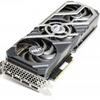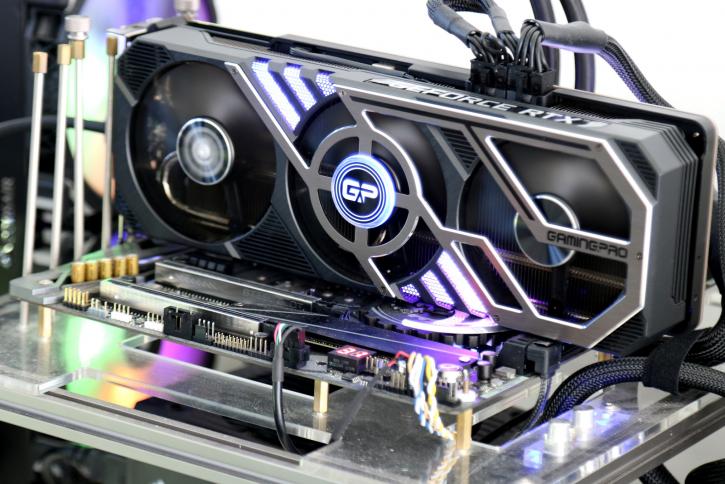Final words and conclusion
.final words
Palit offers a funky dude with the Gaming Pro. It is a good looking product with some serious cooling applied. The three fan cooler manages to keep temps below the reference design as well as keeping acoustics are normalized levels. What we found odd though was the performance level, this OC product performed on the founder edition baseline, so probably Palit is going to issue a BIOS update to squeeze a bit more perf out if it. Then again, if the sole difference is an extra 30 Mhz on the boost clock, really, then that isn't going to so much extra regardlessly seen from that founder edition card. Speaking of the founder edition card, these are a problem for the AIB partners as NVIDIA has released something good and nice-looking with the founder edition. In the end, that will drive the commitment from board partners upward to deliver an even better product. While we're still not sure what availability on the market will be. Palit's GamingPro will need to be sitting at or around that founder edition MSRP to make real sense. It's a nice product that will appeal to many just based on aesthetic design.
.performance
We need to start with performance, it is a generic paragraph used on all RTX 3080 reviews as the performance is more or less the same for all cards and brands. Gaming it can do well, with exceptional values. Yes, at Full HD you'll be quite often bottlenecked and CLU limited. But even there in some games with proper programming and that right API (DX12/ASYNC), the sheer increase in performance is staggering. The good old rasterizer engine first, as hey it is still the leading factor. Pure speaking from a shading/rasterizing point of view you're looking at 125% to 160% performance increases seen (relative) from the similar priced GeForce RTX 2080 (SUPER), so that is a tremendous step. The unimaginable number of shader processors is staggering. The new FP32/INT32 combo clusters remain to be a compromise that will work exceptionally well in most use cases, but likely not all of them. But even then there are so many shader cores that not once the tested graphics card was slower than an RTX 2080 Ti, in fact (and I do mean in GPU bound situations) the RTX 2080 stays ahead by at least a margin of a relative 125%, bot more often 150% and even 160%. Performance-wise we can finally say hey, this is a true Ultra HD capable graphics card (aside from Flight Simulator 2020 haha, that title needs D3D12/AYSNC en some DLSS!). The good news is that with any game that uses traditional rendering will run excellent at 3840x2160. Games that can raytrace and manage DLSS also become playable in UHD.
A good example was battlefield V with Raytracing and DLSS enabled, in Ultra HD now running in that 75 FPS bracket. Well, you've seen the numbers in the review, I'll mute now. DXR Raytracing and tensor performance, the RTX 30 series have been received new tensor and RT cores. So don't let the RT and Tensor core count confuse you. They're located close inside that rendering engine, became more efficient and that shows.
If we look at an RTX 2080 with port Royale, we will hit almost 30 FPS. The RTX 3080 nearly doubles that at 53 FPS. Tensor cores are harder to measure, but overall from what we have seen, it's all in good balance. Overall though, the GeForce RTX 3080 starts to make sense beginning at a Quad HD resolution (2560x1440), but again I deem this to be an Ultra HD targeted product, whereas for 2560x1440 I'd see the GeForce RTX 3070 see playing a more important roll in terms of sense and value for money. At Full HD then the inevitable GeForce RTX 3060, whenever that may be released. Games like Red Dead Redemption will make you aim, shoot, and smile at 70 FPS in UHD resolutions with the very best graphics settings. As always comparing apples and oranges, the performance results vary here and there as each architecture offers advantages and disadvantaged in certain game render workloads. So, for the content creators among us, have you seen the Blender and V_Ray NEXT results? No, go towards page 30 of this review and your eyes will pop out. The sheer compute performance has early exponentially doubled one step in the right direction. We need to stop for a second, and talk VRAM, aka framebuffer memory. The GeForce RTX was fitted with new GDDR6X memory, it clocks in at 19 Gbps, and that is a freakfest of memory bandwidth, which the graphics card really likes. You'll get 10GB of it. I can also tell you that there are plans for a 20GB version. We think initially the 20GB was to be released as the default, but for reasons none other than the bill of materials used, it became 10GB. In the year 2020 that is a very decent amount of graphics memory. Signals are however that the 20GB version may possibly become available in a later stage, for those that want to run Flight Simulator 2020 haha, that was a pun sorry. We feel 10GB right now is fine, but with DirectX Ultimate and added scene complexity and raytracing becoming the new norm, I do not so sure if that's still enough two years from now.
.cooling & noise levels
Depending on the level of airflow inside your chassis, expect the card to sit in the 70 Degrees C range temperature-wise under hefty load conditions, which is just terrific for a card of this caliber. In extremely stressed conditions, we did hit 38 DBA marker, which is considered a silent to normal performing acoustic level.
.energy
The power draw under intensive gaming for GeForce RTX 3080 remains to be significant. We measured it to be close to the 330 Watt range. Now that is a peak value under stressed conditions. Gaming wise that number will fluctuate a bit. Are we happy with that amount of energy consumption in the year 2020? No, not at all. Will you, as an end consumer care about it? We dispute that as well.
.Coil whine
The GamingPRO GeForce RTX 3080 does exhibit a bit coil squeak, however far less than the founder card we tested. Is it disturbing? Well, it's at a level you can hear it softly. In a closed chassis however, that noise would fade away in the background. However, with an open chassis, you can hear a bit of coil whine/squeak.
.pricing
NVIDIA is pricing the GeForce RTX 3080 $699. The AIB product is deemed and damned to be called the more premium products. And I already told you, that's no longer the case anymore as NVIDA's founder cards are directly competing with the AIB product. In a perfect scenario, I would like to see the AIB product cheaper than the founder edition. That's just not the case. This card will be a few tenners more expensive seen over that founder edition card. The price is a substantial 799 EUR incl vat (in the Netherlands).
.Tweaking
We fired of several tweaking scenarios at the card; it's difficult to tweak. Even an automated curve based overclock would not be stable. Much like we have seen with other cards, the tweaks on the clock frequency and memory stick, and run fine, but the performance just was lower. New safety protection is active on memory. A +1000 Mhz would result in poor performance but no stability issues. Ergo +750 max currently is what I'd recommend on the RTX 3080 cards (but this will also differ per caird and brand). Of course, increase the power limiter to the max so your GPU gets more energy budget, and then the GPU clock can be increased anywhere from +40 to +100 MHz, but here again, that will vary per board, brand and card. So in the end I expect 20~21 Gbps on the memory subsystem (effective), and with a +75 Core frequency and added power, you should see your card hovering at a 2 GHz range (which is pretty awesome).
.conclusion
If we filter out the challenges the RTX 3080 has (power consumption and pricing), then we can only acknowledge that the sheer performance this card series brings to the table is anything short from being impressive. You receive a product that will be dominant in that Ultra HD space. Your games average out anywhere from 60 to 100+ FPS, well aside from Flight Simulator 2020. Dropping down in resolutions does create other challenges; you'll be far less GPU bound, but then again we do not expect you to purchase a GeForce RTX 3080 and play games in 1920x1080. Arbitrarily speaking, starting at a monitor 2560x1440 resolution, that's the domain where the GeForce RTX 3080 will start to shine. The raw shading/rasterizer (read a standard rendered game) performance is staggering as this many shader cores make a difference. The new generational architecture tweaks for Raytracing and Tensor also is significant. Coming from the RTX 2080, the RTX 3080 exhibited a roughly 85% performance increase, and that is going to bring hybrid raytracing towards higher resolutions. DXR will remain to be massively demanding of course, but when you can plat Battlefield V iN ultra HD with Raytracing and DLSS enabled at over 70 FPS, hey, I'm cool with that. Also, CUDA compute performance in Blender and V-Ray, OMG. This Palit card in its default configuration sits at founder edition performance. Still, the reality is that all brands likely will different merely a few percent in performance at best anyway. I had hoped it would be a notch faster, but well, perhaps a BIOS update will bring in a bit more perf. Cooling wise, the card is better than the founder card. Design-wise it is an ethically pleasing product to look at, and if it first your gaming budget, recommended.
Sign up to receive a notification when we publish a new article.
Or go back to Guru3D's front page
- Hilbert, LOAD"*",8,1.



